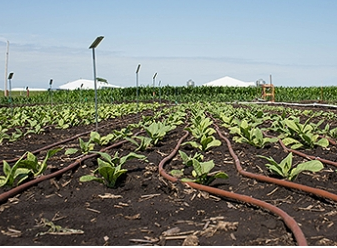
Hacking isn’t just for computers and smart phones. According to a study published last week in the journal Science, scientists have found a way to hack a plant’s genes to make it use sunlight more quickly.
Photosynthesis(光合作用) is the word used to describe how plants use sunlight, water and carbon dioxide to make their own food, and it’s a very slow process. Plants use less than 1% of the energy available to them. But by hacking a plant’s genes, the scientists were able to increase leaf growth on plants between 14 and 20 percent in experiments.
Specifically, scientists hacked the plant’s protective system. “Normally, this system starts working when a plant gets too much sunlight,” said scientist Krishna Niyogi, co-author of the study. When the plant senses the light, it removes extra energy and creates more leaves. When the plant is in shade, the protective system is turned off. But the process is slow. And Stephen Long, the lead author of the study, compared a plant’s protective system to light-adjusting glasses. When a person wears the glasses outside during the day, the lenses darken and lighten depending on how sunny it is. “Plants do the same thing,” he said. But in plants the adjustment can take anywhere from 10 minutes to an hour. This makes it hard for plants to get the right amount of sunlight needed to create food.
The new study sped up the process. By changing the plant’s genes, the protective system turned on and off more quickly than normal. As a result, leaf growth on the plants scientists used in the study increased. Leaf growth in two plants increased by 20%, while leaf growth on a third plant increased by 14%. Scientists conducted the study on tobacco plants. But they think the genetic changes would produce the same results in staples(主食) such as corn and rice.
“Now that we know it works, it won’t be too difficult to do it with other crops,” said Long. “If you look at crops around the world,” he said, “it would increase many million tons of food.”
1.According to the passage, what is the disadvantage of photosynthesis?
A It is easily influenced by weather.
B It makes plants produce much energy.
C It takes little time to function well.
D It makes plants absorb little energy available.
解析:选D。细节理解题。根据第二段Plants use less than 1% of the energy available to them.可知光合作用的不足之处在于它使植物能运用的能量不多,故选D。
2.What is the third paragraph mainly intended to show?
A How plants are influenced by sunlight.
B How a plant’s protective system works.
C How food is produced by plants using sunlight.
D How the protective system is similar to glasses.
解析:选B。段落大意题。根据第三段When the plant senses the light, it removes extra energy and creates more leaves. When the plant is in shade, the protective system is turned off. But the process is slow.和When a person wears the glasses outside during the day, the lenses darken and lighten depending on how sunny it is. Plants do the same thing, he said.可推断第三段旨在介绍植物的保护系统是如何工作的,故选B。
3.What can be inferred about the plant’s protective system from Paragraph 4?
A It works slowly but effectively.
B It is stable and unchangeable.
C It can be improved.
D It can be replaced.
解析:选C。推理判断题。根据第四段By changing the plant’s genes, the protective system turned on and off more quickly than normal.可推断植物的保护系统是可以被改进的,故选C。
4.How can we produce more food according to the study?
A By exposing plants to much sunlight.
B By speeding up plants’ photosynthesis.
C By improving plants’ growing environment.
D By changing plants’ way of using sunlight.
解析:选D。D 推理判断题。根据首段“scientists have found a way to hack a plant’s genes to make it use sunlight more quickly.”和最后一段可推断我们可以通过加快植物吸收阳光的速度来提高产量,故选D。